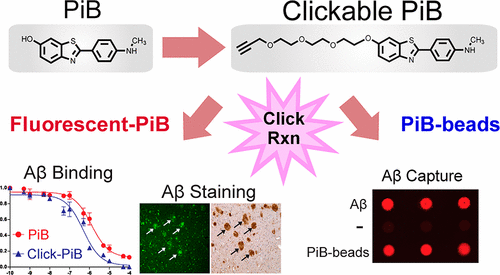当前位置:
X-MOL 学术
›
Bioconjugate Chem.
›
论文详情
Our official English website, www.x-mol.net, welcomes your feedback! (Note: you will need to create a separate account there.)
Generation of Clickable Pittsburgh Compound B for the Detection and Capture of β-Amyloid in Alzheimer’s Disease Brain
Bioconjugate Chemistry ( IF 4.7 ) Pub Date : 2017-09-22 00:00:00 , DOI: 10.1021/acs.bioconjchem.7b00500 Ian Diner 1 , Jeromy Dooyema 1 , Marla Gearing 1 , Lary C. Walker 1 , Nicholas T. Seyfried 1
Bioconjugate Chemistry ( IF 4.7 ) Pub Date : 2017-09-22 00:00:00 , DOI: 10.1021/acs.bioconjchem.7b00500 Ian Diner 1 , Jeromy Dooyema 1 , Marla Gearing 1 , Lary C. Walker 1 , Nicholas T. Seyfried 1
Affiliation

|
The benzothiazole-aniline derivative Pittsburgh Compound B (PiB) is the prototypical amyloid affinity probe developed for the in vivo positron emission tomography (PET) detection of amyloid beta (Aβ) deposits in Alzheimer’s disease (AD). Specific high-affinity binding sites for PiB have been found to vary among AD cases with comparable Aβ load, and they are virtually absent on human-sequence Aβ deposits in animal models, none of which develop the full phenotype of AD. PiB thus could be an informative probe for studying the pathobiology of Aβ, but little is known about the localization of PiB binding at the molecular or structural level. By functionalizing the 6-hydroxy position of PiB with a PEG3 spacer and a terminal alkyne (propargyl) moiety, we have developed a clickable PiB compound that was derivatized with commercially available azide-labeled fluorophores or affinity-tags using copper-catalyzed azide–alkyne cycloaddition reactions, commonly referred to as “click” chemistry. We have determined that both the clickable PiB derivative and its fluorescently labeled conjugate have low nanomolar binding affinities for synthetic Aβ aggregates. Furthermore, the fluorescent-PiB conjugate can effectively bind Aβ aggregates in human AD brain homogenates and tissue sections. By covalently coupling PiB to magnetic beads, Aβ aggregates were also affinity-captured from AD brain extracts. Thus, the clickable PiB derivative described herein can be used to generate a wide variety of covalent conjugates, with applications including the fluorescence detection of Aβ, the ultrastructural localization of PiB binding, and the affinity capture and structural characterization of Aβ and other cofactors from AD brains.
中文翻译:

可检测的匹兹堡化合物B的生成,用于检测和捕获阿尔茨海默氏病脑中的β-淀粉样蛋白
苯并噻唑-苯胺衍生物匹兹堡化合物B(PiB)是原型淀粉样蛋白亲和探针,用于体内正电子发射断层扫描(PET)检测阿尔茨海默氏病(AD)中的淀粉样β(Aβ)沉积物。已经发现,PiB的特异性高亲和力结合位点在具有相似的Aβ负荷的AD病例之间变化,并且在动物模型中的人序列Aβ沉积物上实际上不存在,它们都没有发展出AD的完整表型。因此,PiB可能是研究Aβ病理生物学的有益探针,但对PiB结合在分子或结构水平上的定位知之甚少。通过用PEG 3功能化PiB的6-羟基位置间隔基和末端炔烃(炔丙基)部分,我们开发了一种可点击的PiB化合物,该化合物可通过使用铜催化的叠氮化物-炔烃环加成反应,与市售的叠氮化物标记的荧光团或亲和标签进行衍生化,通常称为“点击”化学。我们已经确定,可点击的PiB衍生物及其荧光标记的缀合物对于合成Aβ聚集体均具有较低的纳摩尔结合亲和力。此外,荧光-PiB缀合物可以有效地结合人AD脑匀浆和组织切片中的Aβ聚集体。通过将PiB与磁珠共价偶联,还可以从AD脑提取物中亲和捕获Aβ聚集体。因此,本文所述的可点击的PiB衍生物可用于生成各种共价结合物,
更新日期:2017-09-23
中文翻译:

可检测的匹兹堡化合物B的生成,用于检测和捕获阿尔茨海默氏病脑中的β-淀粉样蛋白
苯并噻唑-苯胺衍生物匹兹堡化合物B(PiB)是原型淀粉样蛋白亲和探针,用于体内正电子发射断层扫描(PET)检测阿尔茨海默氏病(AD)中的淀粉样β(Aβ)沉积物。已经发现,PiB的特异性高亲和力结合位点在具有相似的Aβ负荷的AD病例之间变化,并且在动物模型中的人序列Aβ沉积物上实际上不存在,它们都没有发展出AD的完整表型。因此,PiB可能是研究Aβ病理生物学的有益探针,但对PiB结合在分子或结构水平上的定位知之甚少。通过用PEG 3功能化PiB的6-羟基位置间隔基和末端炔烃(炔丙基)部分,我们开发了一种可点击的PiB化合物,该化合物可通过使用铜催化的叠氮化物-炔烃环加成反应,与市售的叠氮化物标记的荧光团或亲和标签进行衍生化,通常称为“点击”化学。我们已经确定,可点击的PiB衍生物及其荧光标记的缀合物对于合成Aβ聚集体均具有较低的纳摩尔结合亲和力。此外,荧光-PiB缀合物可以有效地结合人AD脑匀浆和组织切片中的Aβ聚集体。通过将PiB与磁珠共价偶联,还可以从AD脑提取物中亲和捕获Aβ聚集体。因此,本文所述的可点击的PiB衍生物可用于生成各种共价结合物,


























 京公网安备 11010802027423号
京公网安备 11010802027423号